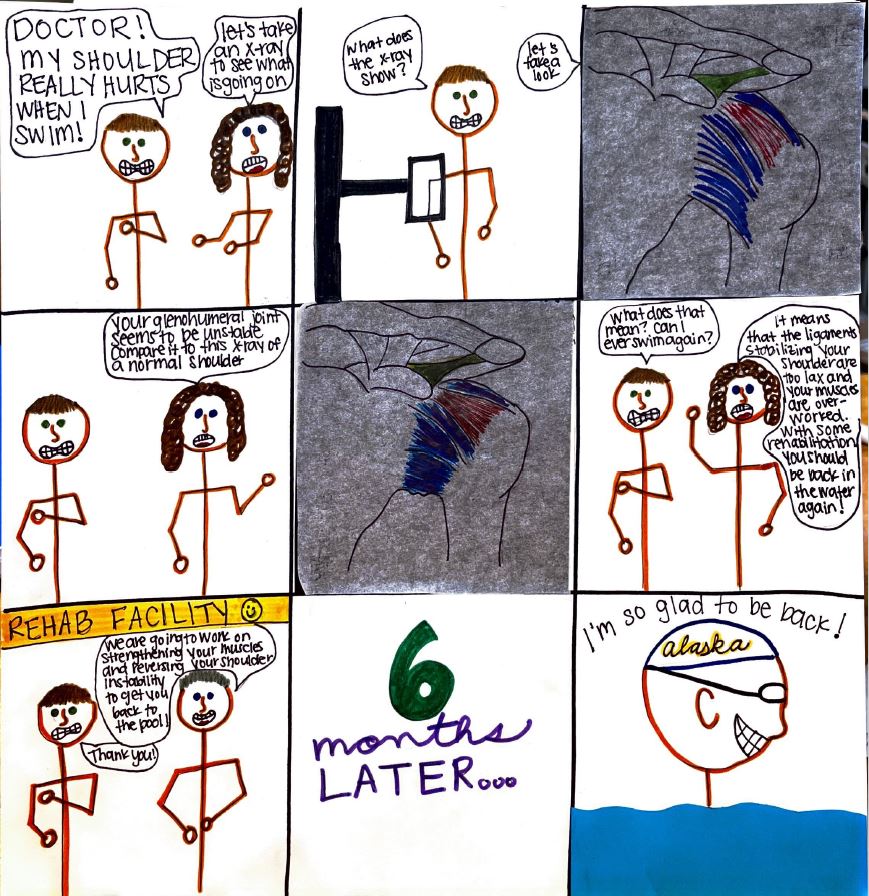
My art project is on Glenohumeral Joint Instability and the objective I am covering is ‘relate the interaction of muscles and the skeletal system’. In my project I have shown a young male athlete having trouble with his shoulder while swimming. When he goes to his doctor for help, he is told that he may have shoulder instability and x-rays are taken to confirm. The doctor shows the young athlete what a normal shoulder should look like and compares it to his own x-ray. After the comparison is made and the young athlete understands why his shoulder is hurting, treatment is started and he comes back to the doctor later saying that his shoulder feels better and that he is ready to return to normal activity.
The glenohumeral joint is a ball-and-socket joint formed by the articulation of the head of the humerus and the glenoid cavity of the scapula (Martini et al., 2015). The major ligaments that are involved with stabilizing the glenohumeral joint include the glenohumeral ligaments (superior, middle, and inferior), coracohumeral ligament, coracoacromial ligament, acromioclavicular ligament, coracoclavicular ligament, and the transverse humeral ligament (Martini et al., 2015). These are the static stabilizers of the shoulder. The glenohumeral ligaments are attached to the scapula via the glenoid labrum, a fibrous and fibrocartilaginous structure, which sits on the edge of the glenoid cavity. The superior and inferior portions have distinctly different morphologies with the inferior portion being round, elevated, and fibrous firmly attached to the glenoid (Itoigawa & Itoi, 2016). The superior portion is meniscal and more loosely attached to the glenoid and more mobile (Itoigawa & Itoi, 2016). The dynamic stabilizers of the shoulder include the supraspinatus, infraspinatus, subscapularis, and teres major muscles which all make up the rotator cuff (Martini et al., 2015).
Imbalances in the relationship between the static and dynamic stabilizers is what causes instability (Itoigawa & Itoi, 2016). A great example of this imbalance is in a competitive swimmer. Glenohumeral laxity is common and can be advantageous for swimmers allowing them to reach farther during the stroke and increase speed and efficiency. However, with the static stabilizers not providing as much stability, the dynamic stabilizers need to make up for it in order to properly control the movements of the glenohumeral joint (De Martino & Rodeo, 2018). This imbalance can cause the rotator cuff muscles to be overloaded, fatigued, and possibly injured.
A Bankart lesion is the detachment of the anterior and inferior labrum and glenohumeral capsule with the anterior band of the inferior glenohumeral ligament (Itoigawa & Itoi, 2016). This is common in patients who have experienced a traumatic anterior dislocation of the shoulder and studies suggest that this anterior to inferior site of the glenoid is the most common site of labral detachment (Itoigawa & Itoi, 2016).
Treatments for shoulder instability include initial instability and restricted activity of the glenohumeral joint followed by rehabilitation (Labriola et al., 2005). It is common for this treatment to fail in younger patients and for them to have recurrent anterior instability (Labriola et al., 2005). Surgical treatments are possible and they minimize the recurrent instability but they may also reduce the normal joint function which would limit the patient’s ability to participate in athletics activities or perform daily overhead activities (Labriola et al., 2005). Treatments can be improved if the location of the instability is focused on.
Resources:
Martini, F., Timmons, M. J., & Tallitsch, R. B. (2015). Chapter 8, Section 5. In Human anatomy (Eighth, pp. 220–222). essay, Pearson.
Labriola, J. E., Lee, T. Q., Debski, R. E., & McMahon, P. J. (2005). Stability and instability of the Glenohumeral Joint: The role of shoulder muscles. Journal of Shoulder and Elbow Surgery, 14(1). https://doi.org/10.1016/j.jse.2004.09.014
Itoigawa, Y., Itoi, E. Anatomy of the capsulolabral complex and rotator interval related to glenohumeral instability. Knee Surg Sports Traumatol Arthrosc 24, 343–349 (2016). https://doi.org/10.1007/s00167-015-3892-1
De Martino, I., Rodeo, S.A. The Swimmer’s Shoulder: Multi-directional Instability. Curr Rev Musculoskelet Med 11, 167–171 (2018). https://doi.org/10.1007/s12178-018-9485-0
